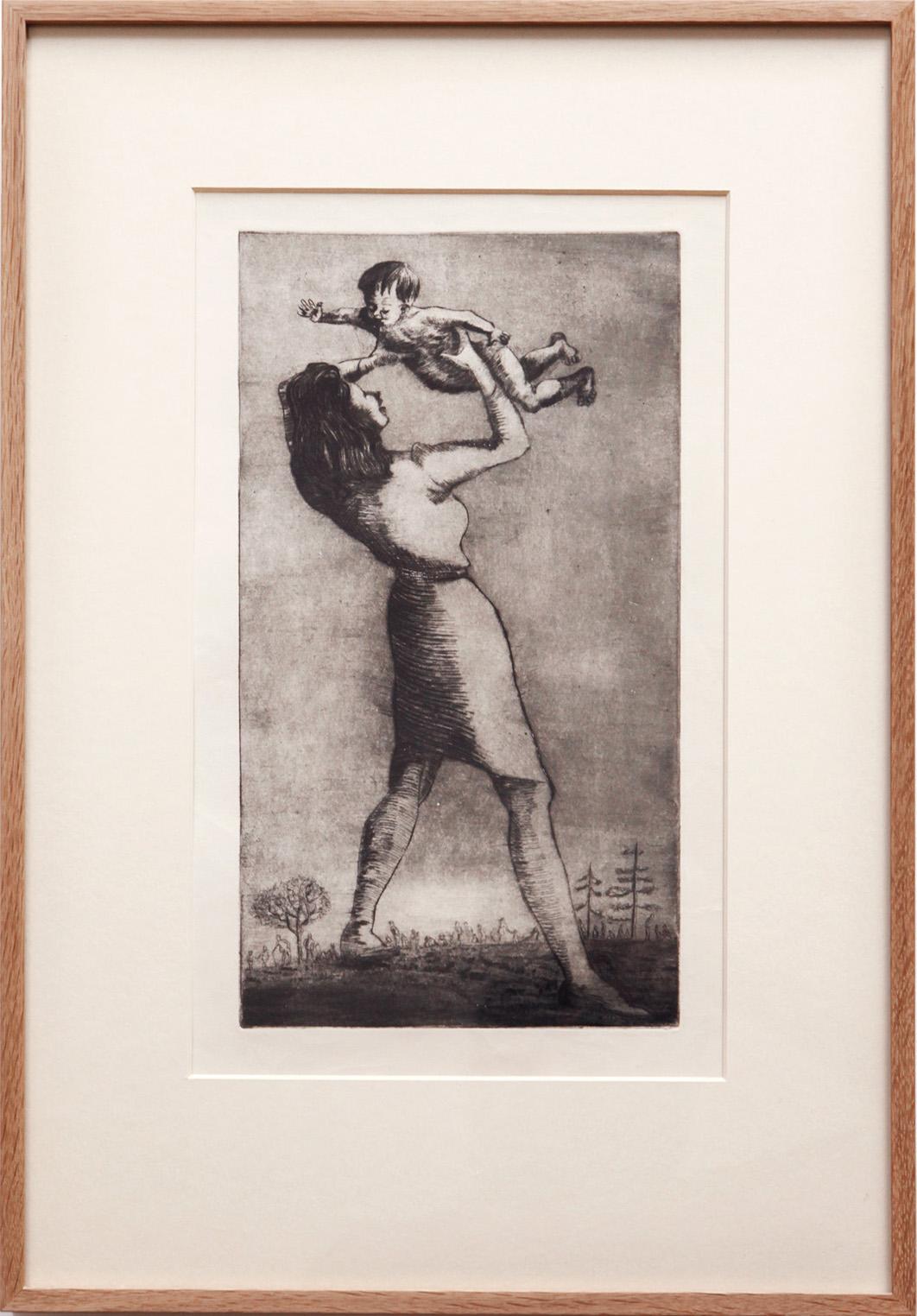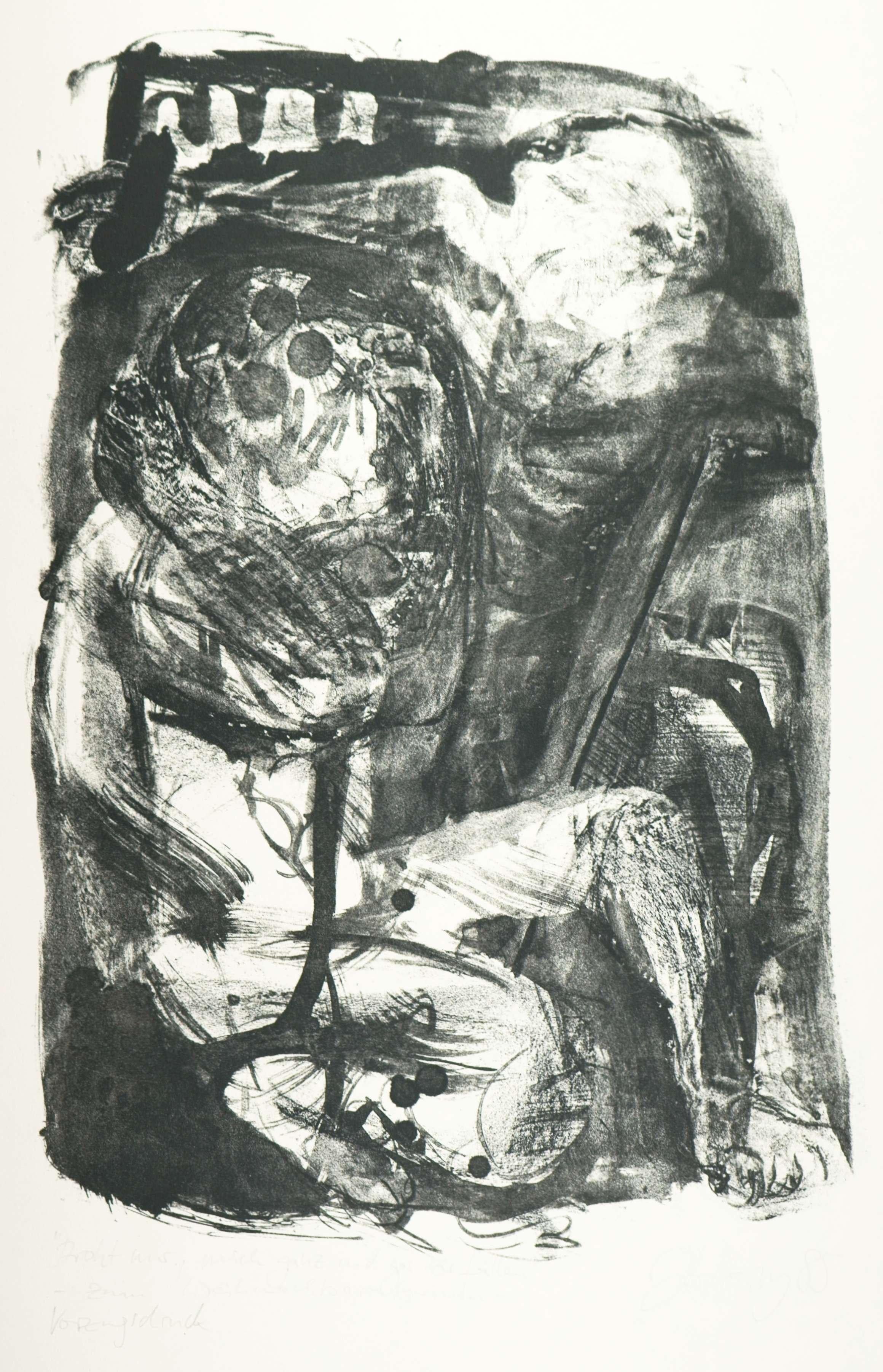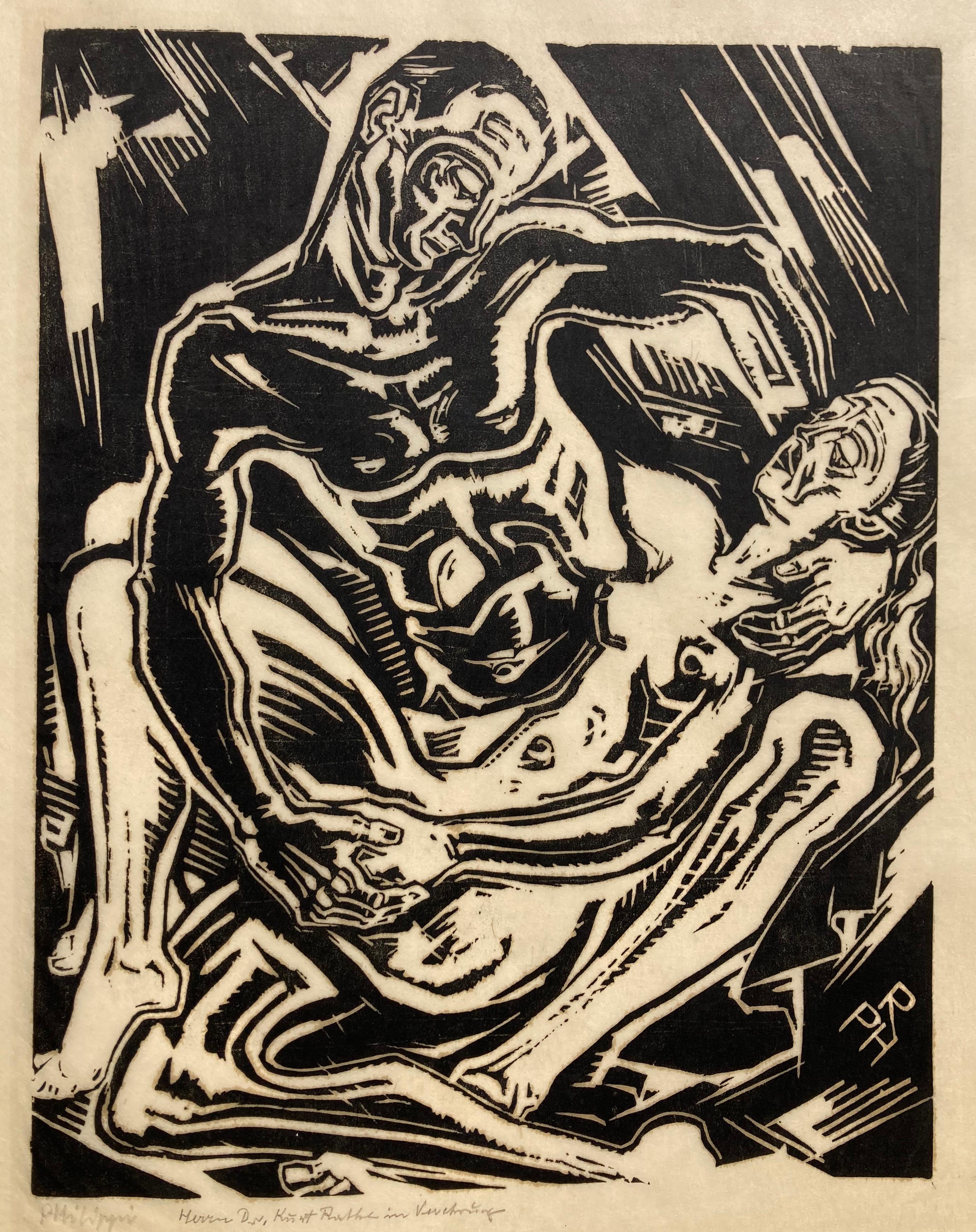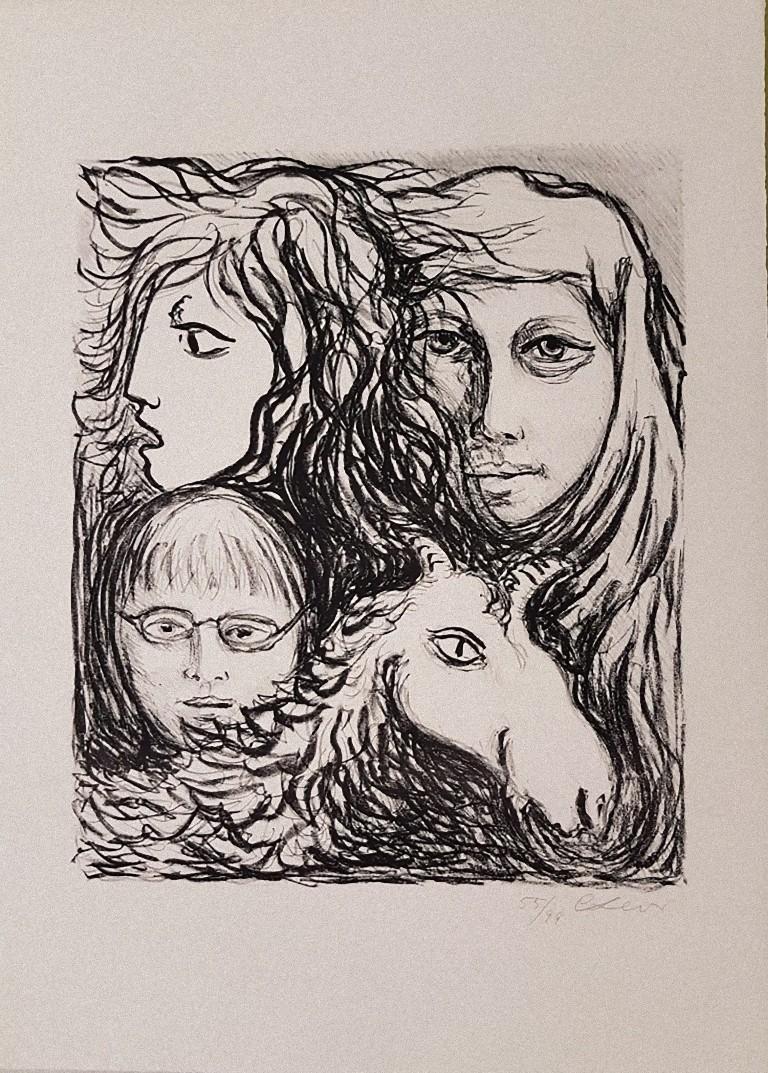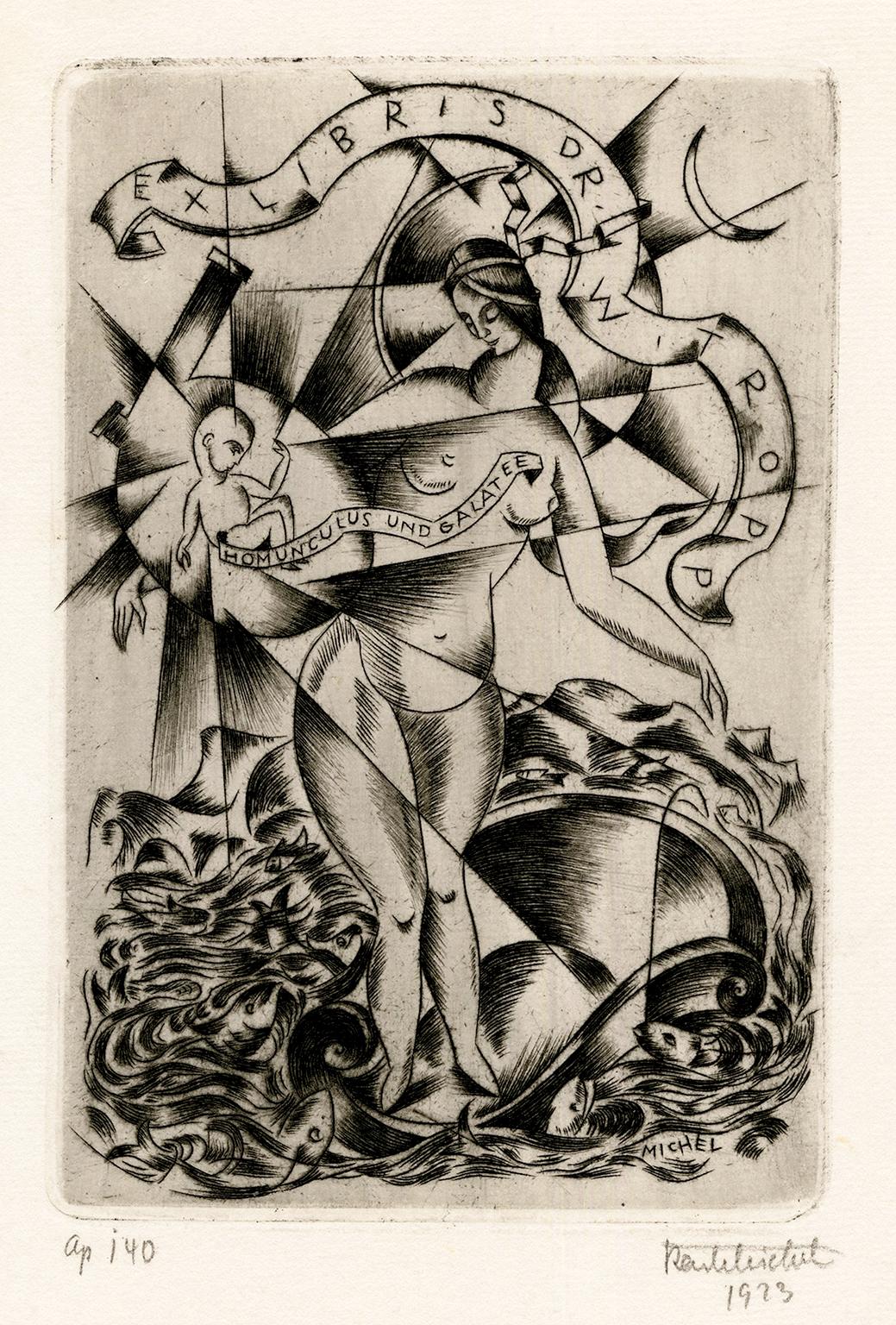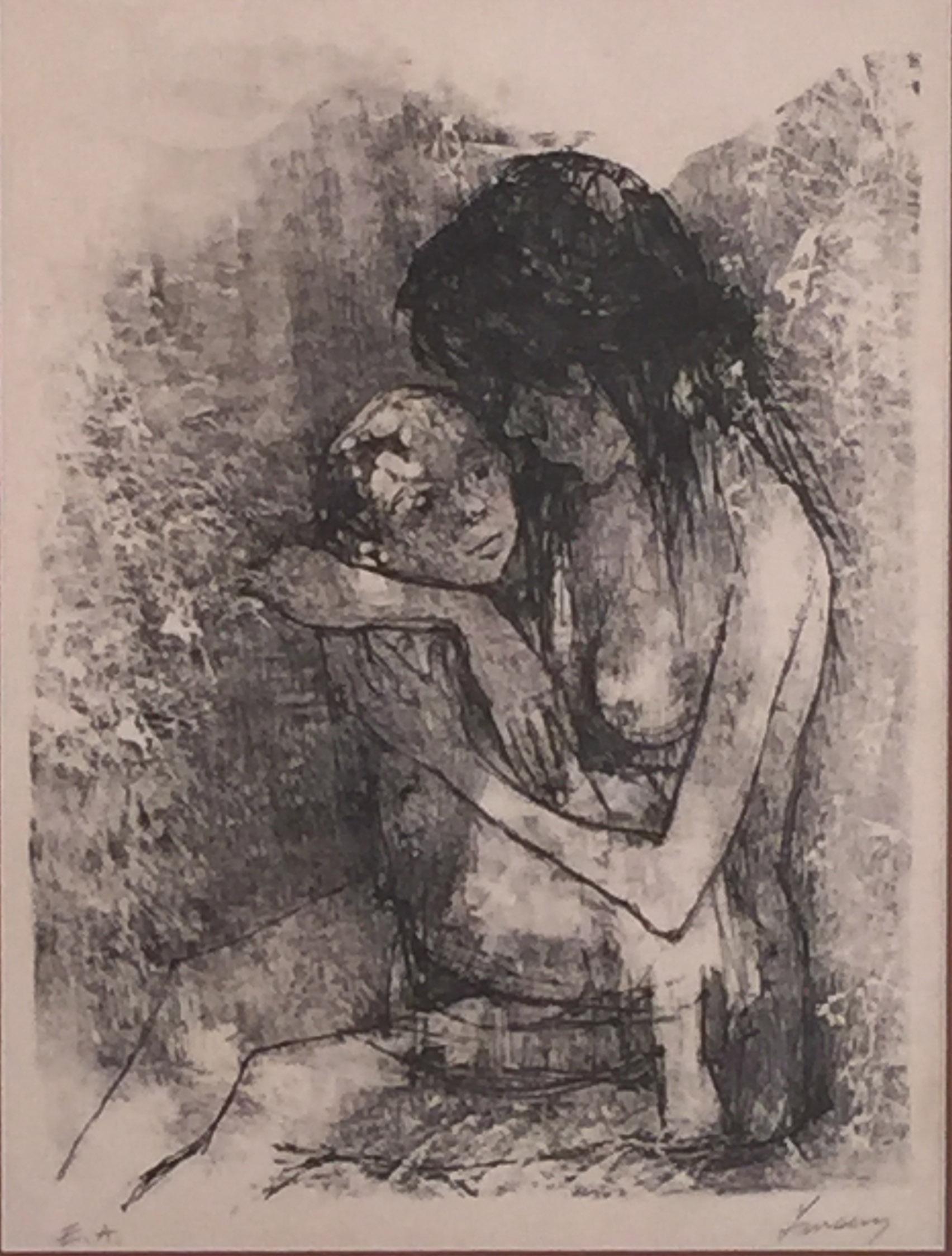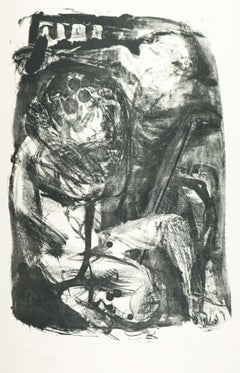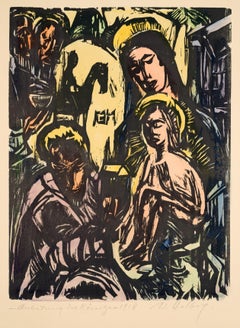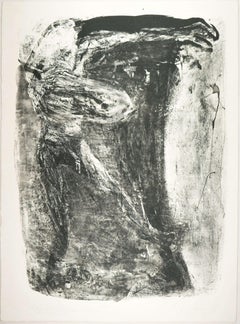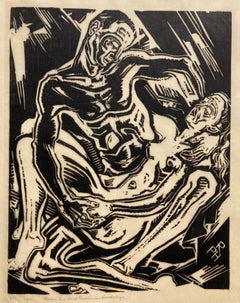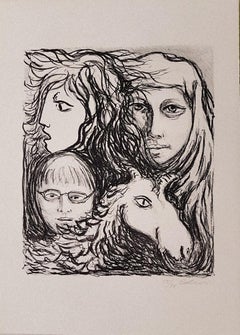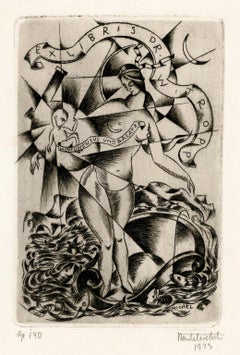Items Similar to The Mother / - Violated Motherhood -
Want more images or videos?
Request additional images or videos from the seller
1 of 7
Georg TappertThe Mother / - Violated Motherhood -1918 (1964)
1918 (1964)
$267.11
$333.8920% Off
£199.80
£249.7520% Off
€224
€28020% Off
CA$369.04
CA$461.3020% Off
A$402.39
A$502.9920% Off
CHF 213.55
CHF 266.9320% Off
MX$4,864.82
MX$6,081.0320% Off
NOK 2,702.59
NOK 3,378.2420% Off
SEK 2,477.30
SEK 3,096.6320% Off
DKK 1,706.51
DKK 2,133.1420% Off
About the Item
Georg Tappert (1880 Berlin - 1957 Berlin), The Mother, 1918 (1964). Estate print from 1964. Linocut on Japan, 31.5 cm x 20 cm (image), 44.5 cm x 28 cm (sheet size), marked lower left in lead as copy 6/20, with the estate stamp on the reverse and signed by the artist's wife, Anneliese Tappert.
- minimal waterstain in the upper and lower left margin, otherwise in excellent condition
- Violated Motherhood -
The mother stands on the heads of her dead children with her arms raised in supplication and her eyes fixed on the heavens. They are the countless senseless victims of a war that has desecrated the sanctity of motherhood. In the background, the city dissolves into an expressionistic cascade of horrific events falling from the sky. The arms and halo of the mother appear several times, transforming the mournful lament into movement.
By drawing on the sacred art of the past, Georg Tappert has created a poignant expressionist 'war memorial'.
About the artist
After studying at the Karlsruhe Art Academy from 1900 to 1903 and an interlude at the Burg Saaleck Art School, Georg Tappert returned to Berlin in 1905, where his works were exhibited by Paul Cassirer. From 1906 to 1908, Tappert lived in the Worpswede artists' colony and ran an art school there. His most important student was Wilhelm Morgner, who died during World War I and whose estate Tappert later worked on. In Worpswede he met Paula Modersohn-Becker, whose art inspired him. When Tappert returned to Berlin in 1910, his works were rejected by the Berlin Secession, and he and Max Pechstein founded the New Secession, which lasted until 1914 and included Franz Marc and Wassily Kandinsky, bringing together artists from the Brücke and the Blaue Reiter. In 1911, together with Käthe Kollwitz, he founded the "Juryfreie" exhibition in Berlin, and in 1918 he co-founded the "Novembergruppe" and the "Arbeitsrat für Kunst". In 1921 he was appointed professor at the Königliche Kunstschule. The Nazis removed him from his post in 1937 and in the same year removed many of his works from museums as 'degenerate'. Tappert withdrew into inner emigration, painting mainly landscapes. After the war, he devoted himself to rebuilding the Kunstgewerbeschule, which he merged with the Kunstgewerbeschule under Karl Hofer.
GERMAN VERSION
Georg Tappert (1880 Berlin - 1957 Berlin), Die Mutter, 1918 (1964). Nachlassdruck von 1964. Linolschnitt auf Japan, 31,5 cm x 20 cm (Darstellung), 44,5 cm x 28 cm (Blattgröße), unten links in Blei als Exemplar 6/20 ausgewiesen, rückseitig mit dem Nachlassstempel versehen und von der Frau des Künstlers, Anneliese Tappert, signiert.
- im linken Randbereich oben und unten mit minimalem Wasserrand, ansonsten in ausgezeichnetem Zustand
- Geschändete Mutterschaft -
Mit flehend erhobenen Armen und zum Himmel gerichtetem Blick steht die Mutter auf den Köpfen ihrer toten Kinder. Es sind die unzähligen sinnlos gestorbenen Kriegsopfer, mit denen die Heiligkeit der Mutterschaft geschändet wurde. Im Hintergrund löst sich die Stadt ist einer expressionistischen Kaskade der grauenhaften himmelstürzenden Ereignisse auf. De Arme und der Heiligenschein der Mutter kommen mehrfach zur Darstellung, wodurch die trauernde Klage zur Bewegung wird.
Georg Tappert schafft hier ein ergreifendes expressionistisches ‚Kriegsdenkmal‘ im Rückgriff auf die sakrale Kunst der Vergangenheit.
zum Künstler
Nach dem Studium an der Kunstakademie Karlsruhe von 1900 bis 1903 und einem Intermezzo an der lebensreformatorischen Kunstschule Burg Saaleck kehrte Georg Tappert 1905 nach Berlin zurück, wo seine Werke von Paul Cassirer ausgestellt wurden. Von 1906 bis 1908 lebte Tappert in der Künstlerkolonie Worpswede und betrieb dort eine Kunstschule. Sein bedeutendster Schüler war der im Ersten Weltkrieg verstorbene Wilhelm Morgner, dessen Nachlass später von Tappert bearbeitet wurde. In Worpswede schloss er Bekanntschaft mit Paula Modersohn-Becker, deren Kunst sie inspirierte. Nachdem, wieder zurück in Berlin, seine Werke 1910 von der ‚Berliner Secession‘ abgelehnt worden waren, gründete Georg Tappert zusammen mit Max Pechstein die bis 1914 bestehende ‚Neue Secession‘, zu der auch Franz Marc und Wassily Kandinsky gehörten, so dass in der ‚Neuen Secession‘ Künstler der ‚Brücke‘ und des ‚Blauen Reiters‘ vereint waren. 1911 rief er zusammen mit Käthe Kollwitz die Berliner Ausstellung der "Juryfreien" ins Leben, 1918 war er Mitbegründer der ‚Novembergruppe‘ und des ‚Arbeitsrats für Kunst‘. 1921 erfolgte der Ruf zum Professor an der stattlichen Kunstschule. Die Nationalsozialisten enthoben ihn 1937 seines Amtes und entfernten im selben Jahr zahlreiche seiner Werke als ‚entartet‘ aus Museen. Tappert zog sich in die innere Emigration zurück und malte hauptsächlich Landschaftsbilder. Nach dem Kriegende widmete er sich dem Wiederaufbau der Hochschule für Kunsterziehung, die er mit der von Karl Hofer geleiteten Hochschule der Künste zusammenlegte.
- Creator:Georg Tappert (1880 - 1957, German)
- Creation Year:1918 (1964)
- Dimensions:Height: 17.33 in (44 cm)Width: 11.03 in (28 cm)
- Medium:
- Movement & Style:
- Period:
- Condition:
- Gallery Location:Berlin, DE
- Reference Number:1stDibs: LU2438216206872
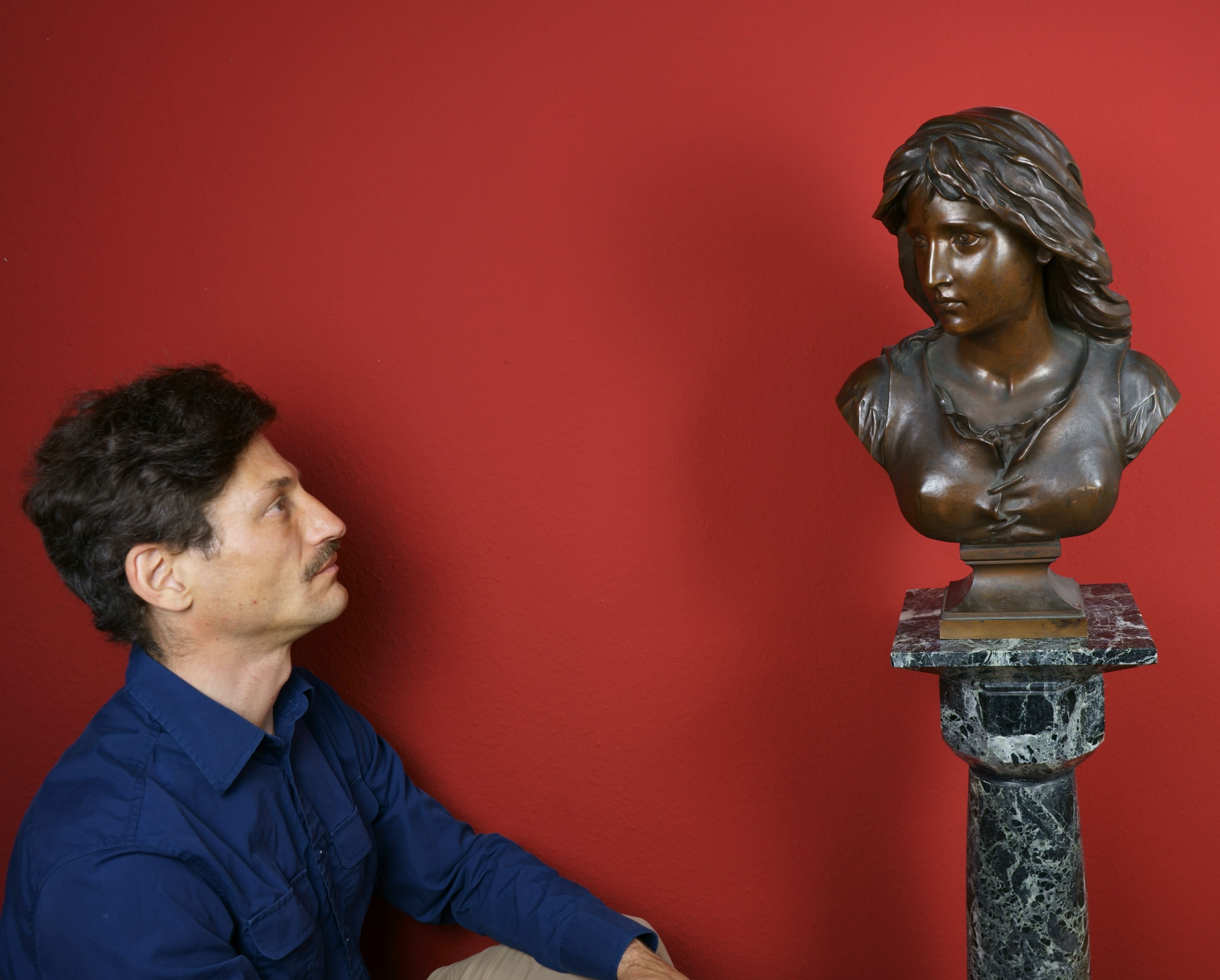
About the Seller
5.0
Vetted Professional Seller
Every seller passes strict standards for authenticity and reliability
Established in 2014
1stDibs seller since 2023
23 sales on 1stDibs
- ShippingRetrieving quote...Shipping from: Berlin, Germany
- Return Policy
More From This Seller
View AllThreatening to defeat me once and for all / - A Christmas Pietà -
Located in Berlin, DE
Johannes Heisig (*1953 Leipzig), "Threatening to defeat me once and for all" - To the Christmas Oratorio by Johann Sebastian Bach. Lithograph on strong yellowish laid paper with wate...
Category
1980s Abstract Expressionist Figurative Prints
Materials
Lithograph
$362 Sale Price
20% Off
The Prophet / - The Burden of the Prophet -
Located in Berlin, DE
Wilhelm Gross (1883 Schlawe - 1974 Oranienburg-Eden), The Prophet, c. 1955. Woodcut on thin laid paper, 43 cm x 23 cm (depiction), 61 cm x 43 cm (sheet size), signed “Dr. Wilh.[elm] Gross” in pencil lower right, inscribed “Orig.[inal] Holzschnitt (Handabdruck)” lower left and inscribed “Aus der ”Ecce homo“ Folge” in the center.
- The wide margin with traces of pressing due to the impression, the sitter's left foot with a small purple stain, otherwise in vibrant condition.
- The Burden of the Prophet -
The large-format woodcut shows a prophet figure that takes up almost the entire height of the sheet. However, instead of seeing something in the distance that is still hidden from our eyes - as is usual in depictions of prophets - the figure has raised his hands in a defensive gesture, as if the prophet is trying to ward off what he has seen. At the same time, however, the position of the arms is an acceptance of the inevitable, which only those who recognize what is to come will have to bear for the time being, which is why the figure in the painting - despite its size - appears almost solitary, alone and exposed to the burden of suffering.
In a manner reminiscent of the folds of medieval wooden sculptures...
Category
1950s Realist Figurative Prints
Materials
Paper
$429 Sale Price
20% Off
Adoration of the Magi / - The Rider of the Sun -
Located in Berlin, DE
Walter Helbig (1878 Falkenstein - 1968 Ascona), Adoration of the Magi, 1918. Hand-colored linocut, 30 cm x 22.5 cm (depiction), 50 cm x 35 cm (sheet size), signed “W.[alter] Helbig” in pencil lower right, inscribed “Adoration of the Magi” lower left and dated “1918”. Below this a handwritten dedication “with heartfelt Christmas greetings”.
- Paper somewhat darkened and with slight creases, thumbtack holes in the corners
- The Rider of the Sun -
The 'apocalypse' of World War I brought about a return to sacred art. Walter Helbig belonged to the circle of the 'Brücke' and the 'Blauer Reiter'. With his reinterpretation of religious themes in an expressionist formal language, Helbig shaped an avant-garde neo-sacred art. This is symbolically expressed in the silhouette of the rider against the sun-like yellow background. It refers to the awakening initiated by the Blue Riding, which is now linked back to the sacred.
The rider and horse "look" at Mary and the Christ Child, who occupy the entire field. Opposite them are the three kings, the eldest of whom kneels before Christ and offers him a gold-filled casket. The expressionist lines give rise to a tower that rises into the "sun", so that the gift has become a Gothic church, expressing the hope that the fallen world will be resurrected in the name of Christ. This dimension of meaning is emphasized by the magical effect of the color scheme.
About the artist
In 1895, Walter Helbig began studying at the Dresden Academy of Art, where he became friends with the future Brücke artist Otto Müller, with whom he lived in Dresden from 1903 to 1905. While studying in Italy from 1897 to 1899, he met Arnold Böcklin and Adolf von Hildebrand. After completing his studies, he first worked for Otto Gussmann, painting churches. From 1905 to 1909 he worked as a freelance painter in Hamburg. In 1909, through the mediation of Otto Müller, Helbig made the acquaintance of artists from the 'Brücke'. In 1910 he exhibited at the founding exhibition of the Berlin 'Neue Sezession'. In the same year, he moved to Switzerland, where, together with Hans Arp and Oscar Lüthy, he founded the 'Moderne Bund' in Weggis, to which Cuno Amiet and Giovanni Giacometti also belonged. At the second exhibition of the 'Moderne Bund' in Zurich in 1911, Henri Matisse and Robert Delaunay were represented alongside artists from the 'Blauer Reiter'. In 1913, Helbig traveled to Paris with Arp and Lüthy. After the dissolution of the 'Moderne Bund', Helbig was represented at the first Dada exhibition in Zurich in 1914. In 1919, he joined the Berlin 'Novembergruppe'. After the devastation of World War I, Helbig turned increasingly to religious themes in his work. In 1924, like many other artists of his time, he moved to Ascona for financial reasons, where he became a naturalized citizen in 1938. There he founded the artists' association "The Great Bear", to which Marianne von Werefkin...
Category
1910s Expressionist Figurative Prints
Materials
Paper
My treasure, my sanctuary / - A Tortured Treasure -
Located in Berlin, DE
Johannes Heisig (*1953 Leipzig), "My treasure, my sanctuary" - To the Christmas Oratorio by Johann Sebastian Bach. Lithograph on strong yellowish laid paper with watermark, 53 x 39.5...
Category
1980s Abstract Expressionist Figurative Prints
Materials
Lithograph
$362 Sale Price
20% Off
Blessed are the merciful / - The support of care -
Located in Berlin, DE
Nehmer, Rudolf (1912-1983), Blessed are the merciful, 1948
Rudolf Nehmer (1912 Bobersberg - 1983 Dresden), Blessed are the merciful, 1948. Woodcut on yellowish wove paper, 18.8 cm x ...
Category
1940s Realist Figurative Prints
Materials
Woodcut
The Zero Hour / - After the End of the World -
Located in Berlin, DE
Rudolf Nehmer (1912 Bobersberg - 1983 Dresden), The Zero Hour, 1948. Woodcut on yellowish wove paper, 20 cm x 14.8 cm (image), 43 cm x 30 cm (sheet size), signed “Rud.[olf] Nehmer” i...
Category
1940s Realist Figurative Prints
Materials
Woodcut
$267 Sale Price
20% Off
You May Also Like
Mother and Child
Located in London, GB
A beautiful and touching original Peter László Péri etching, 1940s. A beaming mother of gigantic proportions holds her child above her head. At her f...
Category
1940s Modern Figurative Prints
Materials
Paper, Etching
LOVERS (LIEBESPAAR
Located in Santa Monica, CA
ROBERT PHILIPPI (Austrian 1877-1959)
LIEBESPAAR (LOVERS) ca.1923 (in Rifkind Collection, LACMA: From a portfolio of 10 prints. Rifkind indicates the e...
Category
1920s Expressionist Figurative Prints
Materials
Woodcut
The Motherhood - Lithograph by Carlo Levi - 1970s
By Carlo Levi
Located in Roma, IT
The Motherhood is an original lithograph on paper by Carlo Levi in 1960s
Hand-signed on the lower right.
Artist's proof.
good conditions except for a lon...
Category
1960s Contemporary Figurative Prints
Materials
Lithograph
'Ex Libris Dr. Witropp' — German Expressionism
By Karl Michel
Located in Myrtle Beach, SC
Karl Michel, 'Ex Libris Dr. Witropp - Homunculus und Galatee', etching, 1923, edition not stated. Signed, dated, and numbered 'Op. 140' (the artist's inventory number) in pencil. Si...
Category
1920s Expressionist Figurative Prints
Materials
Etching
MOTHER AND CHILD
By Jean Jansem
Located in Portland, ME
Jansem, Jean. MOTHER AND CHILD. Lithograph, not dated. Artist's proof aside from an edition of likely 75 or 100. Inscibed "E.A." (Epreuve d'Artiste) and signed in pencil. In very goo...
Category
Mid-20th Century Figurative Prints
Materials
Lithograph
AGONY
Located in Santa Monica, CA
ROBERT PHILIPPI (Austrian 1877-1959)
KNEELING NUDE. c. 1923 (Chrastek, Widder 2019, p. 162, N° 461) (in Rifkind Collection, LACMA: From a portfolio of 1...
Category
1920s Expressionist Figurative Prints
Materials
Woodcut
$600 Sale Price
20% Off
More Ways To Browse
Antique Kunst
Japanese Linocut
Native American Indian Woman
Nechita Peace
Nichi Nichi
Norman Rockwell Plate
Pablo Picasso Cubist Nude 1919 Lithograph
Pablo Picasso Le Vieux Roi
Pablo Picasso Man With Horn
Pablo Picasso Pour Roby
Paul Mohr
Peter Kiss
Peter Max 1970s
Peter Max Cosmic Jumper
Peter Max Silkscreen
Picasso 1963 Lithograph
Picasso Bullfighter Lithograph
Picasso Cranach
